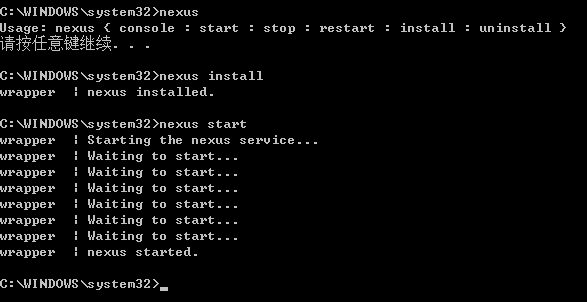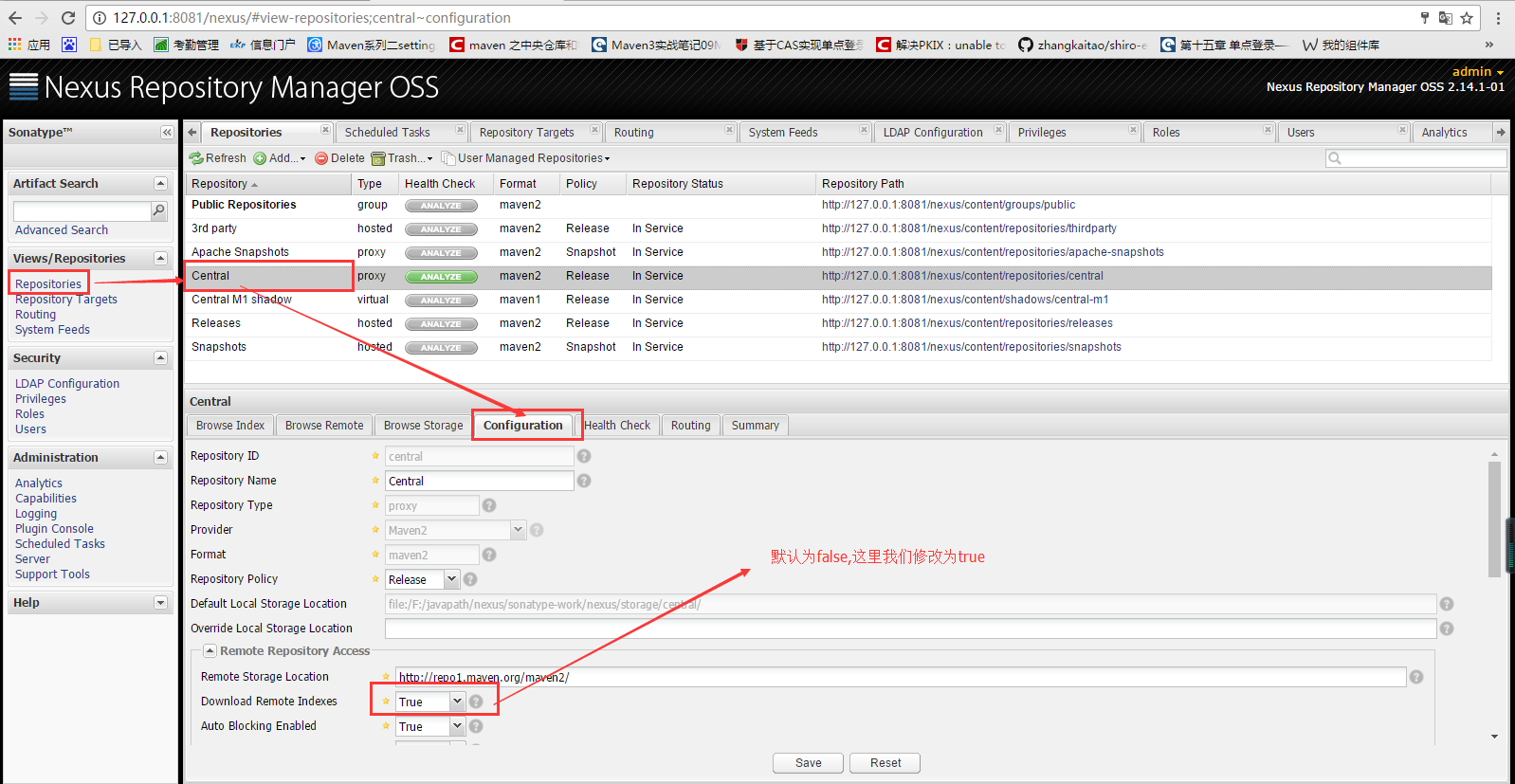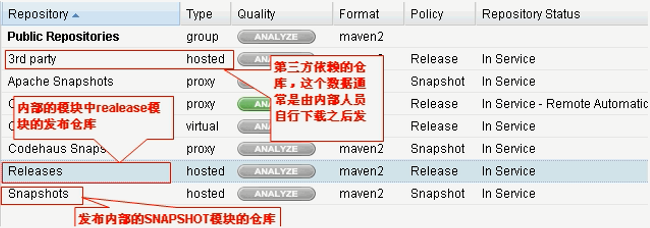Maven私服的简单搭建教程(Nexus)
2019独角兽企业重金招聘Python工程师标准>>> 
第一步,下载nexus的安装包并解压
链接:http://pan.baidu.com/s/1jIhpZ98 密码:6bqx
如果不能下载给我私信,最近也一直在想把这些东西方github上,但是想想自己老是看不懂,就。。。
第二步,将bin添加到环境变量
F:\javapath\nexus\nexus-2.14.1-01\bin

第三步,修改nexus的配置文件
1、F:\javapath\nexus\nexus-2.14.1-01\bin\jsw\conf\wrapper.conf
找里面有这样一个属性wrapper.java.command,将其指向当前的jdk。
wrapper.java.command=F:\javapath\jdk\jdk1.7.0_80\bin\java2、F:\javapath\nexus\nexus-2.14.1-01\conf\nexus.properties
修改配置文件的application-port和application-host,分别指向maven私服的端口号和Ip
application-port=8081
application-host=127.0.0.1第四步,nexus服务的安装

nexus install是将nexus安装到本机服务里,nexus start是启动nexus服务,此时如果访问http://127.0.0.1:8081/nexus


则证明nexus初步跑成功了。
Nexus默认管理用户名和密码为admin/admin123。
第五步,nexus索引的更新,这一步就决定了你的maven私服能不能工作了。

单击左边导航栏的Repositories,选择Central,点击Configuration,里面有一个Download Remote Indexes配置,默认状态是false,将其改为true,‘Save’后,单击Administration==> Scheduled Tasks, 就有一条更新Index的任务,这个是Nexus开始下载中央仓库的索引。由于中央仓库的内容比较多,因此其索引文件比较大,Nexus下载该文件也需要比较长的时间。上班的时间慎用,实在是太耗硬盘了,我这边实测下载速度能到10M/S,更新一次镜像大概要花掉1个小时左右的时间,硬盘一直是100%,电脑卡死,而且我在第一次更新的时候并没有生成Scheduled Tasks,所以并没有索引和镜像的更新,然后重试了两次才好,尤其是maven私服在本地的时候,pom文件增加依赖是瞬间下载。然后就是更新完一次之后基本上就不用再动了,感觉平常跑这个服务队电脑的配置吃的不大,并没有什么影响,只要不手动更新镜像就好。


中央仓库的地址有很多,可以从网上查到,如果感觉到你用的线路很慢的话可以自己手动更改。
hosted仓库,内部项目的发布仓库。

proxy仓库,从远程中央仓库寻找数据的仓库

group仓库,组仓库方便开发人员进行设置的仓库

将多个Repositories添加到public Repositories,我们直接调用就public Repositories的url作为maven仓库的地址就可以
第六步,贴出我的Maven的sitting.xml文件
<?xml version="1.0" encoding="UTF-8"?><!--
Licensed to the Apache Software Foundation (ASF) under one
or more contributor license agreements. See the NOTICE file
distributed with this work for additional information
regarding copyright ownership. The ASF licenses this file
to you under the Apache License, Version 2.0 (the
"License"); you may not use this file except in compliance
with the License. You may obtain a copy of the License athttp://www.apache.org/licenses/LICENSE-2.0Unless required by applicable law or agreed to in writing,
software distributed under the License is distributed on an
"AS IS" BASIS, WITHOUT WARRANTIES OR CONDITIONS OF ANY
KIND, either express or implied. See the License for the
specific language governing permissions and limitations
under the License.
--><!--| This is the configuration file for Maven. It can be specified at two levels:|| 1. User Level. This settings.xml file provides configuration for a single user, | and is normally provided in ${user.home}/.m2/settings.xml.|| NOTE: This location can be overridden with the CLI option:|| -s /path/to/user/settings.xml|| 2. Global Level. This settings.xml file provides configuration for all Maven| users on a machine (assuming they're all using the same Maven| installation). It's normally provided in | ${maven.home}/conf/settings.xml.|| NOTE: This location can be overridden with the CLI option:|| -gs /path/to/global/settings.xml|| The sections in this sample file are intended to give you a running start at| getting the most out of your Maven installation. Where appropriate, the default| values (values used when the setting is not specified) are provided.||-->
<settings xmlns="http://maven.apache.org/SETTINGS/1.0.0" xmlns:xsi="http://www.w3.org/2001/XMLSchema-instance" xsi:schemaLocation="http://maven.apache.org/SETTINGS/1.0.0 http://maven.apache.org/xsd/settings-1.0.0.xsd"><!-- localRepository| The path to the local repository maven will use to store artifacts.|| Default: ${user.home}/.m2/repository<localRepository>/path/to/local/repo</localRepository>--><localRepository>E:\m2e\Repository</localRepository><!-- interactiveMode| This will determine whether maven prompts you when it needs input. If set to false,| maven will use a sensible default value, perhaps based on some other setting, for| the parameter in question.|| Default: true<interactiveMode>true</interactiveMode>--><!-- offline| Determines whether maven should attempt to connect to the network when executing a build.| This will have an effect on artifact downloads, artifact deployment, and others.|| Default: false<offline>false</offline>--><!-- pluginGroups| This is a list of additional group identifiers that will be searched when resolving plugins by their prefix, i.e.| when invoking a command line like "mvn prefix:goal". Maven will automatically add the group identifiers| "org.apache.maven.plugins" and "org.codehaus.mojo" if these are not already contained in the list.|--><pluginGroups><!-- pluginGroup| Specifies a further group identifier to use for plugin lookup.<pluginGroup>com.your.plugins</pluginGroup>--></pluginGroups><!-- proxies| This is a list of proxies which can be used on this machine to connect to the network.| Unless otherwise specified (by system property or command-line switch), the first proxy| specification in this list marked as active will be used.|--><proxies><!-- proxy| Specification for one proxy, to be used in connecting to the network.|<proxy><id>optional</id><active>true</active><protocol>http</protocol><username>proxyuser</username><password>proxypass</password><host>proxy.host.net</host><port>80</port><nonProxyHosts>local.net|some.host.com</nonProxyHosts></proxy>--></proxies><!-- servers| This is a list of authentication profiles, keyed by the server-id used within the system.| Authentication profiles can be used whenever maven must make a connection to a remote server.|--><servers><server><id>releases</id><username>admin</username><password>admin123</password></server><server><id>snapshots</id><username>admin</username><password>admin123</password></server></servers><!-- mirrors| This is a list of mirrors to be used in downloading artifacts from remote repositories.| | It works like this: a POM may declare a repository to use in resolving certain artifacts.| However, this repository may have problems with heavy traffic at times, so people have mirrored| it to several places.|| That repository definition will have a unique id, so we can create a mirror reference for that| repository, to be used as an alternate download site. The mirror site will be the preferred | server for that repository.|--><mirrors><mirror><id>nexus</id><mirrorOf>*</mirrorOf><url>http://127.0.0.1:8081/nexus/content/groups/public</url></mirror></mirrors><!-- profiles| This is a list of profiles which can be activated in a variety of ways, and which can modify| the build process. Profiles provided in the settings.xml are intended to provide local machine-| specific paths and repository locations which allow the build to work in the local environment.|| For example, if you have an integration testing plugin - like cactus - that needs to know where| your Tomcat instance is installed, you can provide a variable here such that the variable is | dereferenced during the build process to configure the cactus plugin.|| As noted above, profiles can be activated in a variety of ways. One way - the activeProfiles| section of this document (settings.xml) - will be discussed later. Another way essentially| relies on the detection of a system property, either matching a particular value for the property,| or merely testing its existence. Profiles can also be activated by JDK version prefix, where a | value of '1.4' might activate a profile when the build is executed on a JDK version of '1.4.2_07'.| Finally, the list of active profiles can be specified directly from the command line.|| NOTE: For profiles defined in the settings.xml, you are restricted to specifying only artifact| repositories, plugin repositories, and free-form properties to be used as configuration| variables for plugins in the POM.||--><profiles><!-- profile| Specifies a set of introductions to the build process, to be activated using one or more of the| mechanisms described above. For inheritance purposes, and to activate profiles via <activatedProfiles/>| or the command line, profiles have to have an ID that is unique.|| An encouraged best practice for profile identification is to use a consistent naming convention| for profiles, such as 'env-dev', 'env-test', 'env-production', 'user-jdcasey', 'user-brett', etc.| This will make it more intuitive to understand what the set of introduced profiles is attempting| to accomplish, particularly when you only have a list of profile id's for debug.|| This profile example uses the JDK version to trigger activation, and provides a JDK-specific repo.<profile><id>jdk-1.4</id><activation><jdk>1.4</jdk></activation><repositories><repository><id>jdk14</id><name>Repository for JDK 1.4 builds</name><url>http://www.myhost.com/maven/jdk14</url><layout>default</layout><snapshotPolicy>always</snapshotPolicy></repository></repositories></profile>--><!--| Here is another profile, activated by the system property 'target-env' with a value of 'dev',| which provides a specific path to the Tomcat instance. To use this, your plugin configuration| might hypothetically look like:|| ...| <plugin>| <groupId>org.myco.myplugins</groupId>| <artifactId>myplugin</artifactId>| | <configuration>| <tomcatLocation>${tomcatPath}</tomcatLocation>| </configuration>| </plugin>| ...|| NOTE: If you just wanted to inject this configuration whenever someone set 'target-env' to| anything, you could just leave off the <value/> inside the activation-property.|<profile><id>env-dev</id><activation><property><name>target-env</name><value>dev</value></property></activation><properties><tomcatPath>/path/to/tomcat/instance</tomcatPath></properties></profile>--><profile><id>nexus</id><repositories><repository><id>dp-repo</id><name>Repository for ane56</name><url>http://127.0.0.1:8081/nexus</url><releases><enabled>true</enabled></releases><snapshots><enabled>true</enabled><updatePolicy>always</updatePolicy><checksumPolicy>ignore</checksumPolicy></snapshots><layout>default</layout></repository><repository><id>releases</id><url>http://127.0.0.1:8081/nexus/content/repositories/releases</url></repository><repository><id>central</id><url>http://central</url><releases><enabled>true</enabled></releases><snapshots><enabled>true</enabled></snapshots></repository></repositories><pluginRepositories><pluginRepository><id>central</id><url>http://central</url><releases><enabled>true</enabled></releases><snapshots><enabled>true</enabled></snapshots></pluginRepository></pluginRepositories></profile></profiles><!-- activeProfiles| List of profiles that are active for all builds.|<activeProfiles><activeProfile>alwaysActiveProfile</activeProfile><activeProfile>anotherAlwaysActiveProfile</activeProfile></activeProfiles>--><activeProfiles><activeProfile>nexus</activeProfile></activeProfiles>
</settings>
在pom.xml文件中私服的指定
<!-- 指定Maven私服地址 --><repositories><repository><id>portal</id><url>http://127.0.0.1:8081/nexus/content/groups/public/</url><releases><enabled>true</enabled></releases><snapshots><enabled>true</enabled></snapshots></repository></repositories>转载于:https://my.oschina.net/ytliyang/blog/803715
Maven私服的简单搭建教程(Nexus)相关推荐
- 饥荒简单搭建教程与自动维护(傻瓜都能学会)
饥荒简单搭建教程与自动维护(傻瓜都能学会) 前言 由于开服之后需要花费大量的时间和精力去维护服务器因此自动维护诞生了.这篇教程从搭建饥荒基本环境到开服,最后到自动维护,内容简易,操作简单.(注意使用此 ...
- Maven 私服的简单使用
所有的 Java 开发者应该是没有没用过 Maven 的吧.Maven 作为 Java 项目管理工具,它不仅可以用作包管理,还有许多的插件,可以支持整个项目的开发.打包.测试.部署等一系列行为.而包管 ...
- 三、Maven私服nexus3服务器搭建
Maven介绍 Apache Maven是一个创新的软件项目管理和综合工具. Maven提供了一个基于项目对象模型(POM)文件的新概念来管理项目的构建,可以从一个中心资料片管理项目构建,报告和文件. ...
- maven私服-详细部署搭建笔记
文章推荐 精选java等全套学习资源 精选java电子图书资源 精选大数据学习资源 java项目练习精选 因为经常需要自行编译,每次从maven下载依赖都是一件很头疼的事情,而且不同的网络环境速度也不 ...
- Linux安装Nexus3搭建maven私服超详细搭建上传步骤
下载nexus3.x 上传nexus压缩包并解压 启动 开启端口号 浏览器访问 编辑 设置开机自启动 运行用户为root (编辑nexus bin下的nexus.rc) 修改nexus3启动时要使用 ...
- Hexo系列(1) - 简单搭建教程与远程部署
前言 搭建个人博客一般有两种选择,一个是使用WordPress,但是需要将博客搭建在服务器上,不过搭建好后写文章方便,适合没有程序基础的人使用.另一个是使用Hexo,相对简洁高效,不需要服务器,既可以 ...
- 使用Nexus搭建Maven私服最详细的教程
环境:linux centos6.5 安装包:nexus-2.12.0-01-bundle.tar.gz 安装 1.将文件上传到目录/usr/local/software 2.我的安装包目录/usr/ ...
- Maven+Struts2+MyBatis+Spring搭建教程
教程目标: 在MyEclipse中搭建Struts2+MyBatis+Spring环境,用Maven管理项目,利用mybatis-gernerator插件生成部分代码 附带目标: struts2的自定 ...
- 原神3.4私服一键包搭建教程windows+linux
windows安装教程 首先安装数据库 mongodb-windows-x86_64-6.0.4-signed.msi 下载地址http://144.22.53.94:1028/s/wwbjme 不要 ...
最新文章
- 王瑜琪:数据科学助力我捕捉研究生教育的宏观效应 | 提升之路系列
- 无法监控端口_如何使用snmp监控linux服务器
- C++: C++函数声明的时候后面加const
- 牛客题霸 [ 最长递增子序列] C++题解/答案
- zabbix proxy mysql_zabbix proxy 配置
- OC基础15:内存管理和自动引用计数
- 第二阶段团队冲刺第九天
- O-矩阵相乘-Warshall算法详解
- HTML5的革新:结构之美
- linux管理员权限下执行popen,执行shell命令的函数——system()、popen()
- PHP100的php教程批量打包下载
- 笔记本电脑连接wifi后突然上不了网解决方法汇总
- 天宝数字水准数据处理和生成
- 一个很好用的深度学习云平台--Floyd
- 使用Python来模拟鼠标的点击; 模拟键盘
- 推荐系统架构与机器学习基础理论
- 2022-2028年中国LCD(液晶显示器)行业市场发展现状及投资策略研究报告
- 解决Mac 80端口被占用
- Fiddler工具 — Fiddler过滤器(Filters)详解
- python 列表嵌套字典 添加修改删除_python 列表、字典、元组等增删改查
